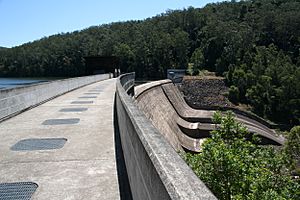Chichester Dam facts for kids
Quick facts for kids Chichester Dam |
|
|---|---|

Chichester Dam
|
|
|
Location of Chichester Dam in
New South Wales |
|
| Country | Australia |
| Location | Dungog, New South Wales |
| Coordinates | 32°13′54″S 151°41′04″E / 32.23167°S 151.68444°E |
| Purpose | Water supply |
| Status | Operational |
| Construction began | 1917 |
| Opening date | 1926 |
| Construction cost | A£1,049,000 |
| Owner(s) | Hunter Water Corporation |
| Dam and spillways | |
| Type of dam | Gravity dam |
| Impounds | Chichester River, Wangat River |
| Height | 43 m (141 ft) |
| Length | 254 m (833 ft) |
| Dam volume | 18.4 ML (650×103 cu ft) |
| Spillway capacity | 3,300 m3/s (120,000 cu ft/s) |
| Reservoir | |
| Creates | Lake Chichester |
| Total capacity | 21,500 ML (760×106 cu ft) |
| Catchment area | 197 km2 (76 sq mi) |
| Surface area | 1.8 km2 (0.69 sq mi) |
| Maximum length | 4.22 km (2.62 mi) |
| Maximum width | 580 m (1,900 ft) |
| Normal elevation | 156.2 m (512 ft) AHD |
| Power station | |
| Operator(s) | Delta Electricity |
| Commission date | November 2001 |
| Type | Conventional |
| Turbines | 1 |
| Installed capacity | 110 kW (150 hp) |
| Annual generation | 0.4 GWh (1.4 TJ) |
Chichester Dam is a concrete dam in New South Wales, Australia. It sits across the Chichester River and Wangat River, near the town of Dungog. Its main job is to provide drinking water for many towns in the Lower Hunter area. Sometimes, a small power station at the dam even makes electricity! The big lake behind the dam is called Lake Chichester.
Contents
What is Chichester Dam?
Chichester Dam is a concrete gravity dam. It was started in 1917 and finished in 1926. The dam is built on the Chichester River, which flows into the Williams River. It is about 21.6 kilometres (13.4 miles) north of Dungog.
How Big is the Dam?
The dam wall is 43 metres (141 feet) high. It is also 254 metres (833 feet) long. The wall was built using a special method with concrete blocks and large rocks.
The dam holds back a huge amount of water. When it's full, it can hold 21,500 million litres (5,680 million US gallons) of water. This water forms Lake Chichester. The lake covers an area of 1.8 square kilometres (0.7 square miles). The area that collects rain for the dam is 197 square kilometres (76 square miles). Much of this area is inside the Barrington Tops National Park.
Water for the Region
Chichester Dam provides about 35% of the water for the Lower Hunter region. This water travels through an 80-kilometre (50-mile) long main pipe. This pipe connects the dam to reservoirs in Maitland, Cessnock, and Newcastle.
History of Chichester Dam
To build the dam and keep the water clean, some land was set aside in 1916. This included parts of the Wangat and Chichester Valleys. The estimated cost to build the dam was about A£1,049,000.
Changes Over Time
Over the years, the dam has been updated to make it safer and better.
- In 1965, the spillway (where extra water flows out) was made lower. This helped the dam handle more floodwater.
- In 1985, strong cables were added to the dam wall. The spillway was also moved back to the middle of the dam.
- In 1995, work was done to stop water from leaking under one part of the dam.
- In 2003, a better drainage system was put in. This helps the dam's foundations stay dry. Also, a wall on the left side was made taller. This helps stop water from flowing over the top during very big floods.
Making Electricity at the Dam
In 1998, a plan was made to add a small hydro-electric power station to Chichester Dam. This was to create electricity and reduce pollution.
How it Works
The power station was finished in 2001. It is operated by Delta Electricity. It uses the flow of water to generate electricity. When a lot of water is flowing, it can make up to 110 kilowatts of electricity. On average, it generates about 0.4 gigawatt-hours of electricity each year. This extra power can be sent to the national electricity grid for homes and businesses to use.


